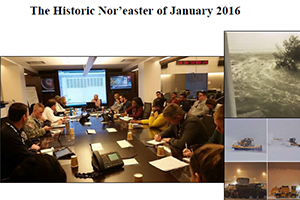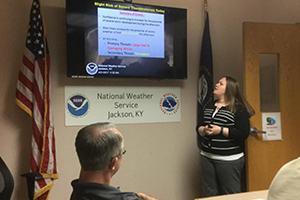Timely and relevant forecasts, watches and warnings are major strengths of the National Weather Service. The agency’s ability to respond quickly to natural disasters with public statements relevant for the protection of life and livelihoods and the advancement of the Nation’s economy is unparalleled. However, new and evolving needs in society call for the NWS to shift to the impact-based decision support services approach.
IDSS are forecast advice and interpretative services the NWS provides to help core partners, such as emergency personnel and public safety officials, make decisions when weather, water and climate impacts the lives and livelihoods of the American people. This support may be needed in response to a particular event or routinely to support high-value decision making. NWS staff across the U.S. work hand-in-hand with partners at local, state and national levels to ensure these decision-makers have the most accurate, reliable and trustworthy weather, water and climate information. The NWS accomplishes this task not only through a commitment to science and technology, but by building trust through deep relationships with key decision-makers across the nation. Deep relationships are developed with those core partners which NWS has a legal mandate to support or whose actions involve national security concerns; who have a high degree of authority for public safety; and who have the capability to amplify NWS messaging to other NWS partners.
In addition to the production and rapid dissemination of accurate and consistent forecast information, the NWS is evolving by continuously working with these key decision makers to answer these questions:
These questions are not answered when impactful weather is ongoing but instead are addressed well before the storm arrives through frequent interaction, simulation exercises, and more effective communication. Furthermore, the answers to these questions are constantly being refined with each passing event and as NWS personnel build deeper relationships with key decision makers.
When impactful events do occur, the method of communication comes in several forms but generally falls into three categories: remote support with forecast advice through various means (such as phone calls, email or online webinars), on-site support at an emergency operations center, or on-site support at an incident or event (such as NWS deployment to a wildfire). The information being communicated to emergency personnel and public safety officials includes detailed information beyond just the most likely scenario. This includes expressing forecast confidence, probabilities of different scenarios occurring, and distinguishing more commonplace weather events from the truly historical or extreme weather and water events.
IDSS Service Description Document v.2
NWS IDSS for Special Events and Enterprise Services
 |
 |
| NWS conducting service assessments with emergency personnel following the Historic Nor’easter of January 2016. | Severe weather briefing to NWS safety and preparedness partner agencies. |